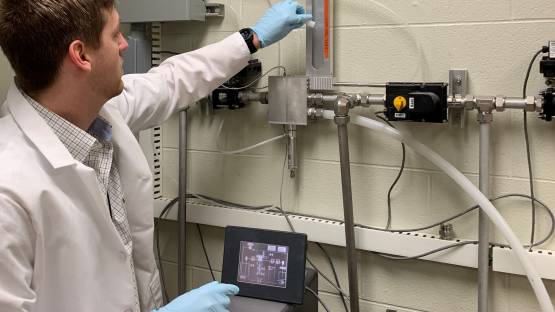The IAEA has recently updated its e-learning material on an established method to find out the composition and origin of materials: neutron activation analysis (NAA). The e-learning course includes new content covering unique details of the technique, updated terminology and expansion of existing modules. The module also offers tests for users to check the knowledge they have acquired through the e-learning course.
NAA is the most commonly used technique in research reactors. It helps determine the elemental ‘fingerprint’ of materials by measuring the radiation of radionuclides after neutron irradiation. It is cost effective and requires low power and neutron flux, which is achievable in most neutron sources based on research reactors or particle accelerators.
“This technique is used in many fields, such as geology, archaeology, pollution control, health and forensics,” said Nuno Pessoa Barradas, Research Reactor Specialist at the IAEA “For instance, it has been used to determine trade routes in ancient civilizations, identify counterfeit coffee, and can help check the quality of air and the source of air pollutants.”
Since its release in 2017, this e-learning course was taken by over 700 participants from 90 countries working in NAA laboratories, research reactor operating organizations, research institutions and universities. It is being used as learning material in undergraduate and graduate courses at universities, including the University of Texas, where Sheldon Landsberger coordinates the Nuclear & Radiation Engineering Academic Program.
“In 2022, I will have 15 graduate students and 6 IAEA fellows in my gamma ray spectrometry course and I will use modules from IAEA e-learning material,” he said.
Updated and improved based on feedback from users, up-to-date knowledge and practices, the e-learning course is aimed at ensuring safe and extended use of NAA both within and outside the nuclear field.
“This course is especially important as it explores the more innovative and unprecedented aspects of NAA, such as its unique capabilities of analyzing large samples, in addition to offering practical aspects of the conduct of NAA, including method validation,” said Peter Bode, an expert from the Netherlands who has contributed to the development of the course.
The course includes new modules on
- ‘Standards, calibrators, and reference materials’, focusing on international standards and reference materials within NAA for calibration, method validation and quality control,
- ‘Sample preparation’, providing approaches for the prevention of contamination and element loss, drying techniques and on homogenization and representativeness, and
- ‘Maintenance of Instrumentation’, zooming in on preventative maintenance for gamma ray spectrometers to help users improve the lifetime and quality of their instrumentation.
The IAEA offers annual proficiency tests through interlaboratory comparison exercises led by the IAEA Nuclear Sciences and Instrumentation Laboratories in Seibersdorf, Austria. Such tests provide countries with the opportunity to have their methods and instrumentation assessed and to receive advice on improvements. Participants are guided towards the NAA e-learning course as preliminary preparation for such proficiency tests and other IAEA workshops on nuclear techniques in research reactors. The IAEA is also developing a publication on practical guides to quality control and quality assurance for NAA, as a result of needs revealed from past proficiency tests.





